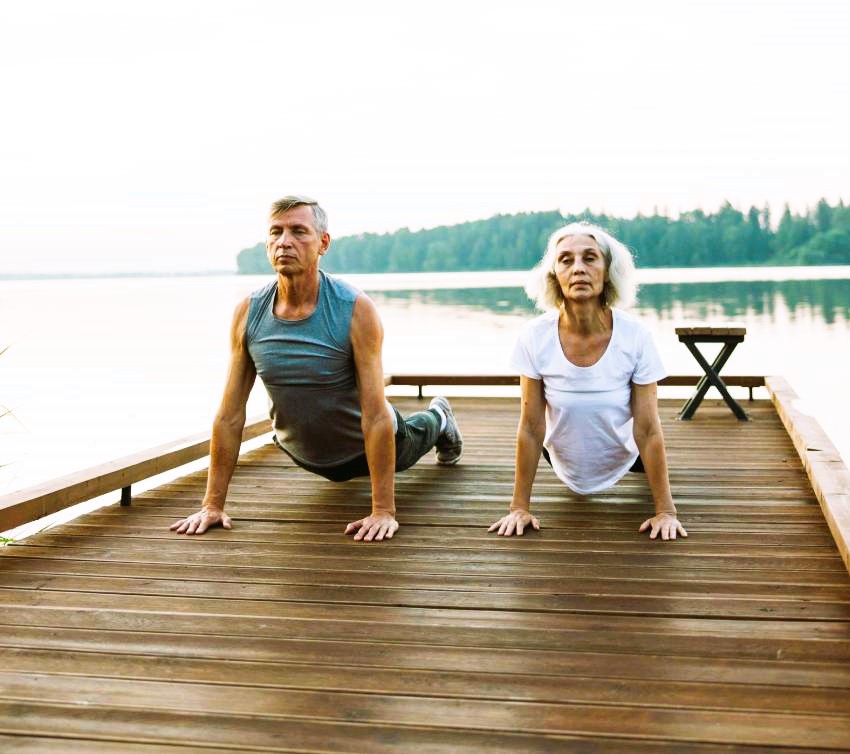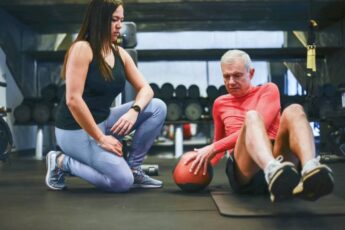Last Updated on September 26, 2025 by Local Trainer
Are you ready to kick-start your fitness journey but worried about aggravating your arthritis? You’re not alone. Many individuals struggle with the desire to stay active while dealing with the limitations of arthritis. This guide is your ticket to a pain-free fitness routine. Discover how to exercise safely, manage discomfort, and make the most of your workouts without causing harm.
Whether you’re dealing with osteoarthritis, rheumatoid arthritis, or other forms of joint pain, this article will equip you with practical tips to tailor your exercises to your specific needs. From gentle stretches to low-impact aerobics, we’ve got you covered. Say goodbye to the fear of movement and embrace a more active and fulfilling lifestyle. Let’s banish the misconception that arthritis and exercise don’t mix.
Get ready to reclaim your strength, flexibility, and overall well-being. It’s time to redefine what it means to work out with arthritis. Say hello to a pain-free fitness routine that empowers and invigorates you.
Understanding arthritis and its impact on exercise
Arthritis is a common condition that affects the joints, causing pain, stiffness, and reduced mobility. There are different types of arthritis, including osteoarthritis and rheumatoid arthritis, each with its own set of challenges. When it comes to exercise, arthritis can make physical activity seem daunting, but it’s important to understand that staying active is crucial for managing the symptoms and maintaining overall health.
Regular exercise can help reduce joint pain and stiffness, increase flexibility, improve strength, and boost energy levels. It also plays a key role in managing weight, which can alleviate pressure on the joints. However, it’s essential to approach exercise with caution and tailor your routine to accommodate the specific needs and limitations imposed by arthritis.
Benefits of exercising with arthritis:
Positive impact on mental and emotional well-being.
Exercise releases endorphins, which are natural mood lifters.
It can help alleviate stress and anxiety.
Additionally, participating in fitness activities can provide a sense of accomplishment and empowerment, boosting self-esteem and confidence.
Furthermore, maintaining an active lifestyle can help individuals with arthritis stay connected to their communities, whether through group fitness classes, walking clubs, or other social activities centered around exercise. The social aspect of exercise can combat feelings of isolation and foster a sense of belonging and camaraderie. By reaping these holistic benefits, individuals can experience an improved quality of life despite their arthritis.
Common misconceptions about exercising with arthritis
One of the most prevalent misconceptions about exercising with arthritis is the belief that physical activity will exacerbate joint pain and cause further damage. While it’s crucial to approach exercise with caution, avoiding physical activity altogether can lead to muscle weakness, decreased joint flexibility, and a decline in overall physical function. It’s important to differentiate between discomfort associated with exertion and pain that signals potential harm.
Another common misconception is that individuals with arthritis should focus solely on rest and inactivity. In reality, a sedentary lifestyle can contribute to increased joint stiffness and reduced range of motion, ultimately worsening the symptoms of arthritis. Finding the right balance between rest and movement is key to managing arthritis effectively. By dispelling these myths, individuals can embrace a more proactive and positive approach to exercise.
Preparing for an arthritis-friendly workout
Before embarking on an arthritis-friendly workout, it’s crucial to consult with a healthcare professional, such as a physiotherapist or rheumatologist, to assess your current physical condition and receive personalized exercise recommendations. A thorough evaluation can help identify any specific limitations or areas of concern, allowing for the development of a tailored fitness plan that aligns with your individual needs and goals.
Furthermore, investing in proper footwear and supportive gear, such as braces or splints, can provide added stability and reduce the risk of injury during exercise. Additionally, considering the time of day for workouts can be beneficial, as many individuals with arthritis experience less stiffness and discomfort in the late morning or early afternoon. By taking these preparatory steps, you can set the stage for a safe and effective workout experience.
Low-impact exercises for arthritis
Low-impact exercises are gentle on the joints, making them ideal for individuals with arthritis. These activities help improve cardiovascular health, enhance flexibility, and strengthen muscles without placing excessive stress on the joints. Walking, swimming, and cycling are excellent low-impact options that can be easily incorporated into a fitness routine.
Aquatic exercises, in particular, offer the benefits of resistance training while minimizing the impact on joints, thanks to the buoyancy of water. Water aerobics, swimming laps, or simply walking in a pool can provide a full-body workout that is gentle on arthritic joints. Tai chi and yoga are also valuable low-impact exercises that focus on gentle movements, balance, and flexibility, promoting relaxation and stress reduction. By including these activities in your workout regimen, you can improve your overall fitness without exacerbating joint pain.
Strength training and flexibility exercises for arthritis
Incorporating strength training and flexibility exercises into your routine can help improve joint stability, enhance muscle tone, and increase range of motion. When engaging in strength training, it’s essential to start with light weights and perform exercises that target major muscle groups while minimizing stress on the joints. Resistance bands can also be used to provide resistance without the need for heavy equipment.
Flexibility exercises, such as gentle stretching and yoga, can help reduce stiffness, improve posture, and alleviate muscle tension. Stretching exercises should be performed in a controlled manner, focusing on each major muscle group to maintain or improve joint flexibility. By incorporating both strength and flexibility exercises, individuals with arthritis can build and maintain muscle strength while preserving joint mobility.
Tips for exercising safely with arthritis
When exercising with arthritis, it’s essential to listen to your body and make adjustments as needed. Pay attention to any discomfort or pain during exercise, and modify your movements or intensity accordingly. Warm-ups and cool-downs are vital components of an arthritis-friendly workout, helping to prepare the body for activity and prevent muscle stiffness or soreness afterward.
Choosing the right exercise intensity is crucial. While it’s important to challenge yourself, pushing too hard can lead to increased joint pain and potential injury. Gradually increasing the duration and intensity of your workouts over time can help build strength and endurance without overwhelming your joints. Additionally, maintaining proper posture and alignment during exercise can reduce the strain on joints and minimize the risk of injury.
Finding support and motivation for arthritis-friendly fitness
Staying motivated to exercise with arthritis can be challenging, especially when faced with discomfort or fatigue. Seeking support from friends, family, or a support group can provide encouragement, accountability, and a sense of camaraderie. Sharing your fitness journey with others who understand the challenges of exercising with arthritis can be both uplifting and inspiring.
Setting realistic and achievable fitness goals can also help maintain motivation. Celebrate your progress, no matter how small, and acknowledge the positive impact that regular exercise is having on your overall well-being. Additionally, exploring new and enjoyable fitness activities can keep your workouts fresh and engaging, preventing boredom and monotony. By cultivating a support system and establishing meaningful goals, you can stay motivated and committed to your arthritis-friendly fitness routine.
Professional guidance and resources for arthritis-friendly exercise
Seeking professional guidance from certified fitness trainers or physical therapists who have experience working with individuals with arthritis can provide valuable insights and personalized exercise plans. These professionals can offer expertise in developing safe and effective workout routines tailored to accommodate the specific needs and challenges associated with arthritis.
Furthermore, exploring specialized exercise programs designed for individuals with arthritis, such as Arthritis Foundation exercise classes or online resources, can expand your options for engaging in fitness activities that are both safe and beneficial. These programs often incorporate evidence-based practices and expert guidance, ensuring that participants receive the support and instruction needed to exercise with confidence and comfort. By tapping into professional resources, individuals can access the knowledge and guidance necessary to pursue an arthritis-friendly fitness regimen.
Conclusion
In conclusion, exercising with arthritis is not only possible but incredibly beneficial. By understanding the impact of arthritis on exercise, recognizing the benefits of staying active, addressing common misconceptions, and preparing for an arthritis-friendly workout, individuals can embrace a pain-free fitness routine that promotes strength, flexibility, and overall well-being. Incorporating low-impact exercises, strength training, flexibility exercises, and following safety tips can empower individuals to exercise safely and effectively with arthritis.
By finding support, staying motivated, and seeking professional guidance, individuals can navigate their fitness journey with confidence and determination. It’s time to banish the misconception that arthritis and exercise don’t mix and redefine what it means to work out with arthritis. Say goodbye to the fear of movement and embrace a more active and fulfilling lifestyle. It’s time to reclaim your strength, flexibility, and overall well-being through a pain-free fitness routine that empowers and invigorates you.
Local Trainer




